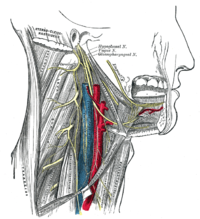
Photo from wikipedia
Purpose: To evaluate lower tear meniscus and corneal sub-basal nerve plexus in primary Sjögren's syndrome (pSS) and Sicca syndrome patients. Methods: Cross-sectional study of 116 patients with Sicca syndrome associated… Click to show full abstract
Purpose: To evaluate lower tear meniscus and corneal sub-basal nerve plexus in primary Sjögren's syndrome (pSS) and Sicca syndrome patients. Methods: Cross-sectional study of 116 patients with Sicca syndrome associated with pSS and not associated with Sjögren's syndrome (non-SS Sicca) and 20 normal control subjects. Tear meniscus height and area were measured using anterior segment optical coherence tomography; corneal sub-basal nerve plexus density, length, and tortuosity were evaluated using in vivo confocal microscopy. Data analysis was performed using IBM-SPSS Statistics 24.0. Results: Corneal sub-basal nerve plexus density and length were significantly lower, and tortuosity was significantly higher in pSS and non-SS Sicca groups than in normal control subjects (P < 0.001; P = 0.018, respectively). Corneal sub-basal nerve plexus presented a strong association with Schirmer test I and tear breakup time. Cutoff values of sub-basal nerve plexus density (36.5 nerve/mm2) and length (12.5 mm/mm2) presented 80.2% to 81.9% sensitivity and 85% specificity for detecting Sicca syndrome patients. No significant differences were found between the 3 groups regarding tear meniscus height and area. Conclusions: Corneal sub-basal nerve plexus in vivo confocal microscopy may be a useful tool in the assessment of dry eye disease in Sicca syndrome, complementing the information provided by the conventional modalities used in dry eye disease evaluation.
Journal Title: Cornea
Year Published: 2019
Link to full text (if available)
Share on Social Media: Sign Up to like & get
recommendations!